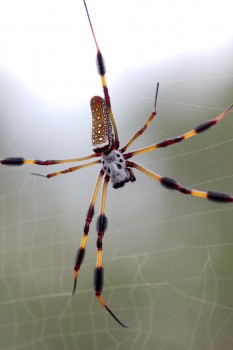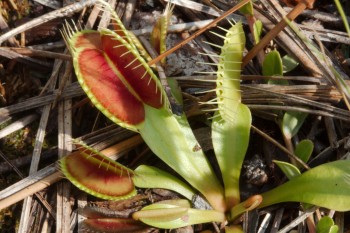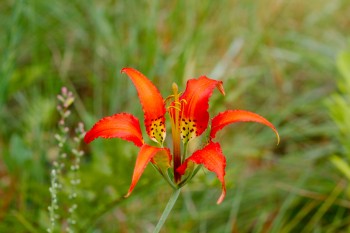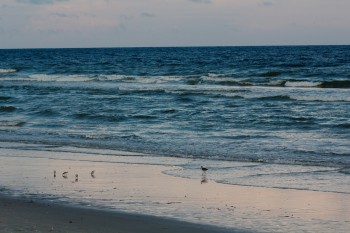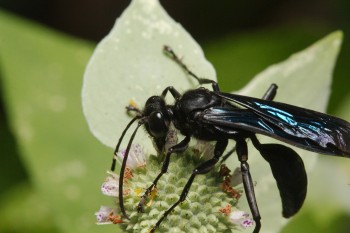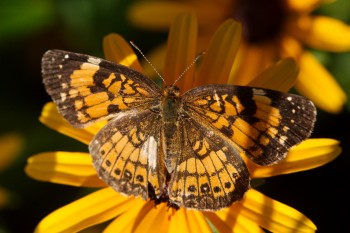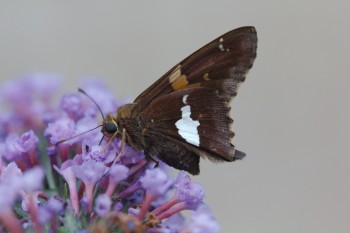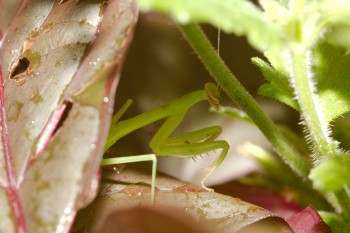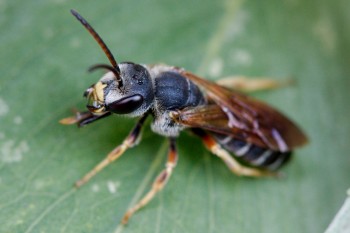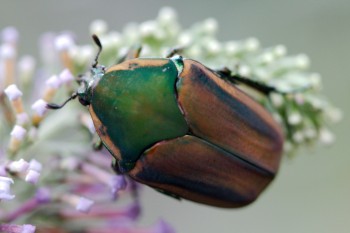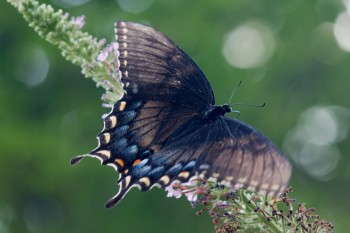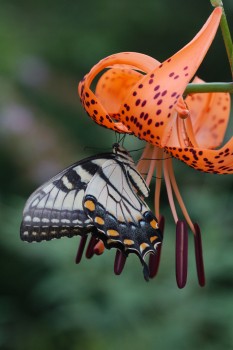Today’s picture is of the portion of our family that was at the beach this year. We missed having Stephen, Maya, and Iris, who have come in recent years. We also missed Brady, George, and Carmela, although they haven’t been, at least not in a long while. But, we did have Karlee, Dorothy, Henry, Cathy, Albert, Dot, Ralph, and Tsai-Hong. While Karlee isn’t technically in our family, she’s been with us at the beach six of the last eight years and we didn’t go to the beach the other two, either.
Monthly Archives: July 2013
Nephila clavipes (Golden Silk Orbweaver)
This is the third of three pictures I’m posting for July 30. If you don’t like spiders, you may not want to click on this image. This is probably the biggest spider I’ve seen outside of captivity. It isn’t as big as some tarantulas I’ve seen but they were in terraria. The body of the female golden silk orbweaver can be up to nearly two inches long although this one is probably not more than 1.5 inches. With the legs it’s more like six inches. The male, who was on the web nearby, is less than an inch across including his legs and is not nearly as fearsome looking.
In past years we have found sundews on the ground near the banks of a small pond as we enter the Green Swamp. This year the pond had more water and where we had seen them was covered. I was walking through the trees to the shore of the pond when I nearly walked through this spider’s web. She would not have been happy with me if I had not seen her. Then again, I wouldn’t have been all that thrilled to have her climbing on my head and neck. Fortunately I saw a glint of light on the web just before I hit it.
Dionaea muscipula (Venus Flytrap)
Here’s a second picture from July 30, again from the Green Swamp in southern North Carolina. The first year we visited we saw a lot of Venus flytraps. The second year it was very dry and we didn’t see any at all. Last year and this they were back in large numbers and we stopped to get a few new pictures. They are a bit hard to photograph, partly because they are so small.
Here you can see a few open “traps” as well as one that has closed, presumably on some prey.
Lilium catesbaei (Pine Lily)
For the last few years we’ve been making a trek to the Green Swamp when we’ve come to the beach. In the past it’s been very hot, usually in the upper 90s and very humid. This year was a bit different. It was still very humid but the temperature was somewhere in the mid 80s. Still hot and sticky but not nearly so oppressive. On the other hand, the mosquitoes were much worse this year than in the past.
One flower we haven’t seen on prior visits is the pine lily, Lilium catesbaei. There were a few of them out, mostly finishing up their blooming period. This one still looked quite nice, though. They are very striking in a place where green is such a dominant color.
Bonus points for the spider in the picture. I didn’t see him when I took it.
Boat Reflections
One evening when we’re at the beach we all go to dinner at Dockside, a seafood restaurant in Calabash, almost into South Carolina. Because with a part of more than 20 people we generally have a pretty significant wait to get in, we all walk around on the nearby dock. This picture is of the reflection of a fishing boat.
Sunrise, Ocean Isle Beach
One issue that I typically have at the beach is that the house is kept pretty cool and outside it is both warm and very humid. That means that when I go out, especially first thing in the morning, my camera fogs up and I have to wait a while before I can take any pictures. We switched houses for this year and the new house has a room that is not air conditioned. In the spring or fall that room is probably very comfortable but in late July and August it is quite warm. But it means I could leave my camera there and when I went outside with it, the lens didn’t fog up.
Anyway, I went out this morning, long after the sun was actually up, but the picture is still sort of sunrise-like. The beginning of a pretty day.
Ocean Isle Beach
Our summer was mostly only busy for Dorothy up through this weekend. Cathy and I continued to work. On July 27, though, we began three weeks of vacation, which is something I’ve been looking forward to for a few months. We started with a week at the beach. The beach, for us, generally means Ocean Isle Beach in southern North Carolina. On the day we arrived it was cloudy but very pleasant out. We went for a short walk on the beach just before sunset and I took a couple pictures of the ocean. This one is nice because it has a few birds in it — Least Sandpipers (Calidris minutilla) and a Willet (Tringa semipalmata).
Sphex pensylvanicus (Great Black Wasp)
As it gets hotter and hotter, the bees seem to get thicker and thicker on the mountain mint (Pycnanthemum muticum). The great black wasp (Sphex pensylvanicus is a bit hard to photograph well. In general, it’s easier to photograph something with a bit of contrast in it but the great black wasp is pretty much a uniform black. It’s also not an insect that you can take a lot of time with. It’s constantly on the move. For a huge, dangerous looking wasp, it also seems to be relatively shy and doesn’t like to be approached. Still, I’m reasonably pleased with this shot.
Cinnamon Toast Crunch
This isn’t exactly the breakfast of champions. Nor is it the most spectacular picture for reintroducing my blog after a month. It is, however, one of only a handful of photographs that I took on July 25. The others have a bit more color in them but aren’t much more interesting. I’m just hoping that I’ll be able to keep your interest. Don’t worry, though, because I have some travel pictures coming soon.
Server Crash
I was a few days behind in posting pictures here because I was at the beach, enjoying myself and not thinking too much about responsibilities. While I was in that mode, my server crashed. That actually happened sometime on August 1 or 2. Then, we returned from the beach and left about 36 hours later for two weeks in England. The server was down all that time. I have it mostly back up and running and will begin posting pictures from the missing days.
Rest assured that there are pictures for every day, although, as usual, I don’t promise that they are any good.
Chlosyne nycteis (Silvery Checkerspot)
This is a cute little butterfly that’s appeared in our garden the last few days. It is a silvery checkerspot, Chlosyne nycteis, one of a genus of 20 to 25 species. It’s a smallish thing, between 1.5 and 2 inches across and seems quite fond of the black-eyed Susans, although they are on the mountain mint, as well, with about a jillion bees and wasps. The mountain mint has really come into full bee-attracting mode. There must be hundreds on that one small patch at any given time, especially in the heat of the day when the sun is shining on it.
Phoropter
I went to the eye doctor today. All seems well and I did very well on the peripheral vision test. He said he doesn’t see a lot of perfect scores but I got one with one eye and only missed one dot with the other, so that’s good news. He’s following two issues but said that neither is causing any problem and I don’t need to come more than once a year. While I was waiting, though I took this picture of the phoropter, although he didn’t actually use it this visit. My eye sight hasn’t really changed since I got my glasses.
Epargyreus clarus (Silver-spotted Skipper)
It’s another insect! Aren’t you excited? This one is a skipper, a silver-spotted skipper (Epargyreus clarus) to be precise. It’s a fairly large skipper and quite common, although I’ve only seen a half dozen or so of them so far. We have dozens upon dozens of smaller grass skippers (subfamily Hesperiinae). It’s a busy time in the garden right now. This skipper is on the buddleia, as you can clearly see.
Mantis religiosa (European or Praying Mantis)
This isn’t a great picture but I was competing with a 10-year old who was trying to get a better view of it while I was trying to get a photograph. Actually, she was trying to “help” me get a clear view and she was moving the leaves around. Of course, the mantis didn’t stay in one place very long and I was lucky to get two pictures, both reasonably sharp. This is a small mantis, about two inches long. Metamorphosis in mantises is called hemimetabolism. The larval stage looks basically like the adult, only smaller (and without wings). As they grow, they shed their exoskeleton a number of times.
Halictus parallelus (A Sweat Bee)
I’m pretty pleased with this picture of a leaf-cutting bee. It could be better, to be sure, but I’m pretty psyched with it. The best part, in my view, is what it shows about bees’ eyes. Most people are familiar with the fact that most insects have compound eyes. These compound eyes are called oculi (singular oculus) and are made up of up to 9,000 ommatidia, the individual components of the eyes. What you may not know is that many insects have three additional simple eyes, called ocelli (singular ocellus) on the top of their head, arranged in a triangle. That’s right, they have five eyes, not two.
If you enlarge this image you should be able to see the three “additional” eyes on this leaf-cutting bee’s head. You’ll also get a nice view of the mandibles that she uses to cut pieces of leaf (thus the common name) to use as separators between cells of her nest.
Update: The good folks at BugGuide.net have identified this as Halictus parallelus (A Sweat Bee) (and a male, at that) rather than a Megachile (Leaf-cutting Bee). I have change the title and the caption on the photograph to reflect this.
Sunset Colors
I don’t have a lot to say about this picture, my third posted for July 19. We were stopping to see a friend and this was what the sky looked like as we got there. This was taken with a 100mm lens. The sky was mostly dark at this point and there was just this one small area of color, but what color it was! Wonderful.
Cotinis nitida (Green June Beetle)
I saw a new insect today. Well, not technically a new insect, but one I haven’t photographed before. This is a fairly large beetle, about an inch long. It was up on the buddleia bush and I was able to get a reasonably sharp picture, although not as sharp as I’d like. It’s a little like a giant Japanese beetle, but it’s a green June beetle, Cotinis nitida, a North American native. They are generally considered to be pests, because their larvae eat the roots of many plants including grasses and ornamentals.
Black-eyed Susans
Here’s another black-eyed Susan picture. They sure do well in our yard, and we might need to cut them back a bit after they finish blooming, so that they don’t take over completely. The black-eyed Susan is the state flower of Maryland, by the way and in case you didn’t know. A good choice, I think. There are a couple dozen Rudbeckia species and they are named after Olof Rudbeck the Younger (1660-1740) and his father, Olof Rudbeck the Elder (1630-1702), both professors of botany at Uppsala University. The name was given by Carolus Linnaeus, who was their student.
Dark Phase Tiger Swallowtail
At the risk of overdoing one subject, here’s another picture of a tiger swallowtail (Papilio glaucus). As you can see, this looks a bit different to the others I’ve posted lately. There is a dark phase which occurs in females through much of its range.
This little lady was playing hard to get, moving to the top of the buddleia (butterfly bush) and staying on the far side as I circled trying to get a good look at her. This is the best I could do, and it isn’t bad, anyway.
Tiger Swallowtail on Tiger Lily
As I left for work this morning I saw this tiger swallowtail butterfly (Papilio glaucus) on a tiger lily (Lilium lancifolium). I didn’t think I could let that opportunity pass without at least trying to get a picture. I took quite a few, starting relatively far away and working in a bit closer as she didn’t fly off. I am pretty happy with a good number of the images.
She kept circling the flower and would occasionally open her wings, but most of the good pictures show her in profile, like this. I did get a couple that are mostly of the butterfly and don’t show the entire flower, but I thought I’d use this one here. A few were closer still and in them you can see the individual scales on the butterfly’s wing.
It’s turned quite hot the last day or three and I was glad to get my photo-taking out of the way in the morning. That way I didn’t have to do it later in the day or even when I got home. My car said it was 101°F at 5:30 PM.


